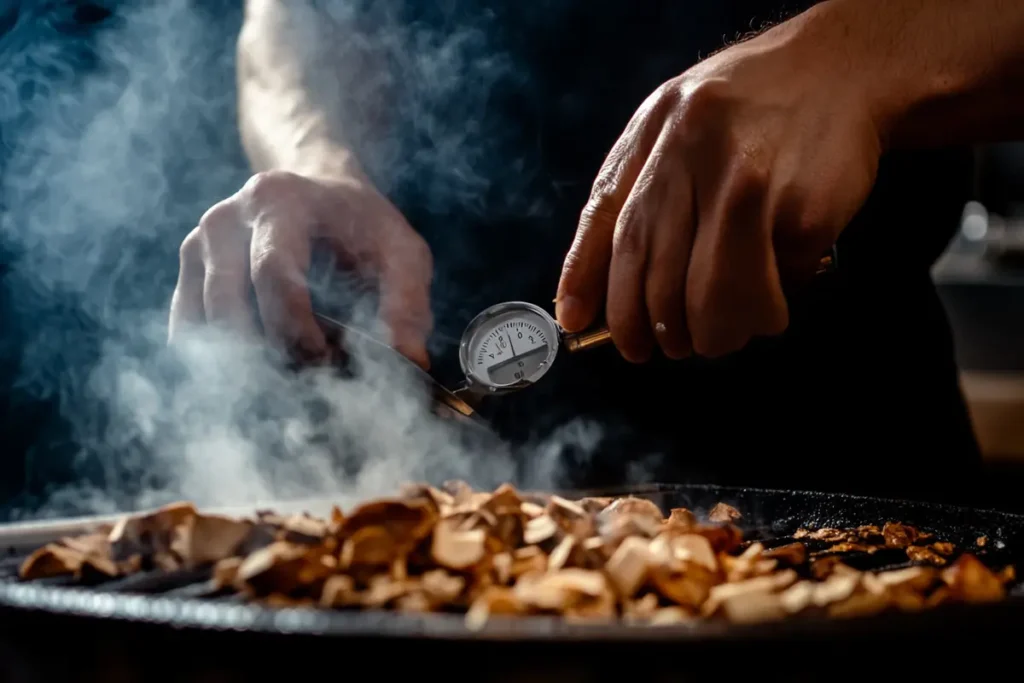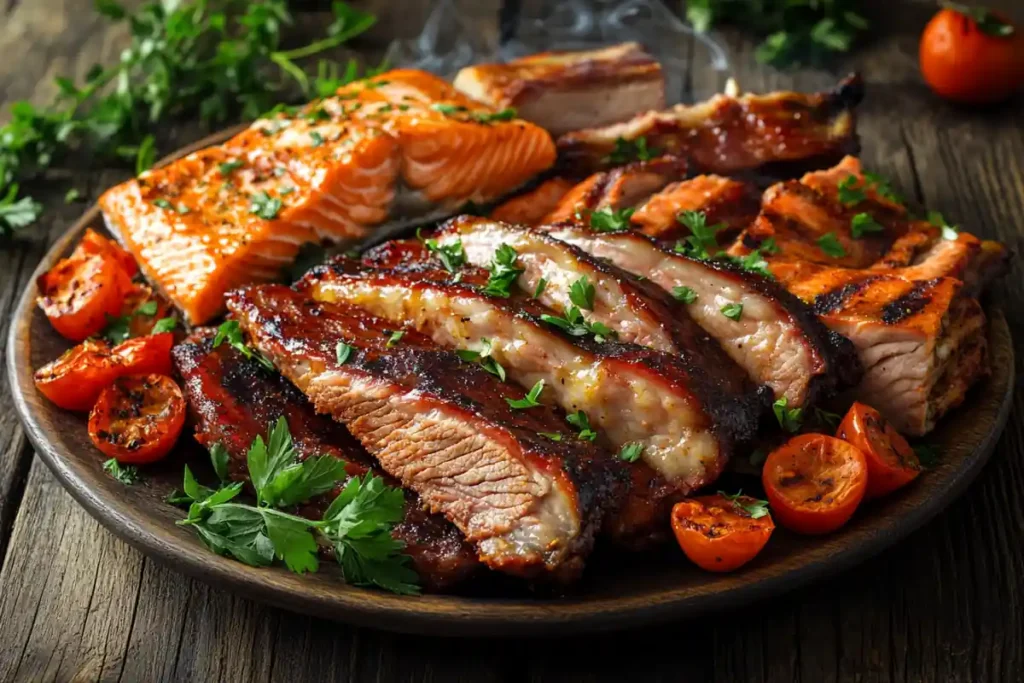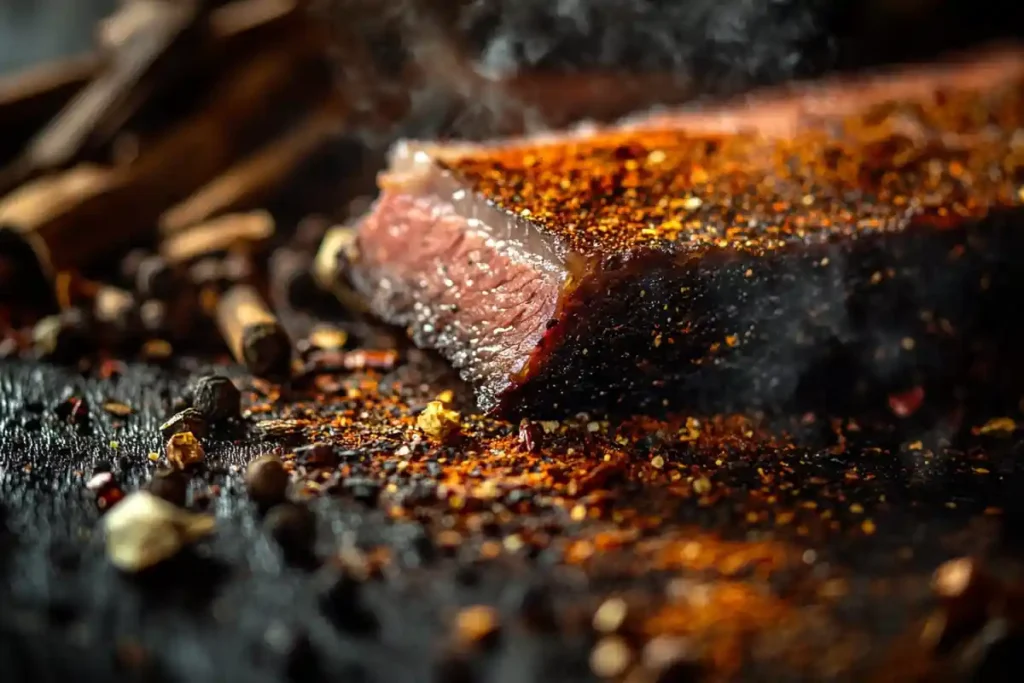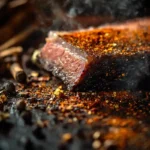Smoked foods have always been synonymous with rich, bold flavors that captivate the senses. From the tantalizing aroma of slow-smoked meats to the surprising textures of smoked vegetables, there’s something magical about using a smoker to transform simple ingredients into culinary masterpieces. In this article, we’ll explore every aspect of creating exceptional smoker recipes, from understanding your smoker to crafting unforgettable dishes. Whether you’re a novice or an experienced pitmaster, there’s something here for everyone. Let’s dive in!
Basics of Smoker Recipes
Understanding Smokers and Their Role
Smokers are not just cooking tools; they’re flavor enhancers. Using low, indirect heat and wood smoke, smokers infuse food with a unique taste that’s hard to replicate. The choice of smoker can make or break your culinary adventures. For example, electric smokers are ideal for beginners due to their ease of use, while charcoal smokers deliver a more authentic, smoky flavor for those ready to invest a bit more effort.
Choosing the right smoker depends on your experience and the type of food you want to smoke. If you’re after convenience, consider a pellet smoker. For a hands-on experience, try a wood-fired smoker. Each type has its quirks, but they all promise one thing: exceptional flavor.
Key Ingredients in Smoker Recipes
Creating great smoked dishes begins with selecting the right ingredients. It’s not just about the meat or vegetables; the type of wood chips you use plays a huge role too. Popular options include:
- Hickory: Bold and smoky, perfect for beef or chicken.
- Applewood: Sweet and mild, ideal for pork and poultry.
- Cherrywood: Adds a rich, fruity note to smoked foods.
Don’t overlook your rubs and marinades. A great spice blend can elevate any dish. Common ingredients in rubs include paprika, brown sugar, garlic powder, and cumin. For marinades, consider fresh herbs, citrus juices, and soy-based sauces to add layers of complexity to your dish.
Essential Tools for Smoking Success
To master smoker recipes, having the right tools is just as important as choosing the right ingredients. Start with a reliable thermometer to monitor both your food’s internal temperature and the smoker’s ambient heat. Drip pans are indispensable for catching juices and maintaining moisture. Tongs, gloves, and brushes round out the basics.
For added convenience, invest in smoker-friendly accessories like rib racks or fish baskets. These tools keep your food evenly cooked and prevent sticking or tearing.
Prepping Your Smoker

Preparation is the unsung hero of great smoking. Before you even think about cooking, your smoker needs some love. Start by cleaning it thoroughly to remove any leftover residue from past sessions. Then, season it by running it at high heat with a handful of wood chips. This not only cleans the inside but also primes the smoker for optimal performance.
When setting up your smoker, consistency is key. Ensure a steady heat source, and arrange wood chips or charcoal for even distribution. It’s tempting to rush, but taking your time during prep will save you from headaches later.
Popular Smoker Recipes
Smoking food opens a world of culinary possibilities, where each ingredient is infused with rich, bold flavors. This section highlights not only the best meats to smoke but also vegetarian delights, quick and unique recipes, and even desserts. Whether you’re a meat lover or exploring plant-based options, these smoker recipes promise to inspire.
Best Meats for Smoking

When it comes to meats, smoking adds a depth of flavor unmatched by other cooking methods. Here’s how to make the most of different types of meat in your smoker.
Beef
Smoked beef is a classic for a reason—it’s hearty, flavorful, and satisfying.
- Brisket: The crown jewel of smoked beef recipes. Start with a high-quality brisket, trim excess fat, and generously apply a dry rub made with paprika, salt, pepper, garlic powder, and cayenne. Smoke it at 225°F for 10-12 hours, spritzing with apple cider vinegar every few hours for extra moisture. Let it rest before slicing to ensure juiciness.
- Short Ribs: These tender, fall-off-the-bone ribs are perfect for smoking. Marinate them overnight in soy sauce, garlic, and honey, then smoke at 250°F for 5-6 hours.
Chicken
Smoked chicken delivers unbeatable flavor and versatility.
- Whole Chicken: Brining is crucial to keep the meat moist and flavorful. Combine water, salt, sugar, and herbs to create a simple brine, then submerge the chicken overnight. Before smoking, coat the chicken with olive oil and a spice rub. Smoke at 250°F for about 4 hours or until the internal temperature reaches 165°F.
- Wings: For quick crowd-pleasers, smoke chicken wings seasoned with your favorite dry rub. Toss them in BBQ sauce and finish with a quick broil for a caramelized glaze.
Fish
Fish absorbs smoky flavors quickly, making it a fantastic option for smoking.
- Salmon: Brine fillets in a mixture of salt, brown sugar, and water for at least 4 hours to enhance the flavor. Smoke at 160°F for 2-3 hours until the salmon is tender and flaky. Serve with a lemon-dill sauce for a refreshing finish.
- Trout: Whole smoked trout, seasoned with herbs like dill and thyme, is another excellent choice.
Turkey
For a special occasion or simply a hearty meal, smoked turkey is a showstopper. Brine the turkey overnight, then smoke at 225°F for approximately 30-40 minutes per pound.
Vegetarian Smoker Recipes
Vegetarian options might not be the first thing that comes to mind when you think of smokers, but they’re just as exciting and delicious. Smoking elevates the flavors of vegetables, legumes, and even cheese, transforming them into hearty dishes.
- Smoked Eggplant: Cut eggplant into thick slices, brush with olive oil, and season with garlic, smoked paprika, and salt. Smoke at 225°F for 1.5 hours until soft and smoky.
- Stuffed Bell Peppers: Hollow out peppers and fill them with a mix of quinoa, black beans, corn, and cheese. Smoke at 250°F for 2 hours until the peppers are tender and the filling is heated through.
- Smoked Tofu: Press tofu to remove excess moisture, marinate in soy sauce and sesame oil, and smoke for 1 hour at 225°F.
Smoked vegetables and tofu are fantastic as main dishes or as sides to accompany smoked meats.
Unique and Quick Smoker Recipes
Not all smoker recipes require hours of preparation. If you’re short on time but still want to enjoy the rich flavors of smoked food, these recipes are for you.
- Smoked Nuts: Toss almonds, cashews, or pecans in olive oil and sprinkle with your favorite spices like smoked paprika or garlic powder. Smoke at 250°F for 30-40 minutes, stirring occasionally to ensure even flavor. Perfect as a snack or topping for salads.
- Smoked Cheese: Cold smoking is the best way to add flavor to semi-hard cheeses like gouda or cheddar. Set your smoker to 90°F and smoke the cheese for 2 hours. Wrap it in parchment and refrigerate for a week before enjoying to let the flavors develop fully.
- Smoked Mushrooms: Large portobello mushrooms make an excellent, smoky alternative to burgers. Marinate with balsamic vinegar and rosemary, then smoke at 225°F for 1.5 hours.
These quick recipes are ideal for entertaining or simply adding a smoky twist to everyday meals.
Smoking Desserts
Smoking isn’t just for savory dishes. Desserts infused with subtle smoky flavors can surprise and delight your guests. Here are some innovative ideas:
- Smoked Cheesecake: Prepare your cheesecake as usual but bake it in the smoker at 250°F for 2 hours. The smoke adds a rich, slightly caramelized flavor that pairs beautifully with a graham cracker crust.
- Smoked Fruits: Fresh fruits like peaches, apples, and pineapples are delicious when smoked. Slice and brush with honey or maple syrup, then smoke for 30 minutes to intensify their natural sweetness. Serve as a dessert or use as a topping for ice cream or pancakes.
Advanced Techniques for Smoking Perfection
Mastering Smoking Techniques

Smoking is equal parts science and art, and achieving perfection means mastering a few advanced techniques. One hallmark of a well-smoked dish is the smoke ring, that beautiful pink layer beneath the surface of meats like brisket or ribs. This visual cue signals a properly executed smoking process and is achieved by maintaining consistent temperatures and using the right amount of wood chips.
Balance is another key aspect. Too much smoke can overpower the natural flavors of your food, while too little won’t give you the depth you’re after. A general rule? Use mild woods like apple or cherry for delicate items like fish and stronger ones like hickory for robust meats.
Another tip: layering flavors. Combine rubs, marinades, and basting to create complex, nuanced profiles. For instance, try a sweet-and-spicy rub for ribs, followed by a tangy BBQ sauce glaze during the final hour of smoking.
Troubleshooting Common Smoker Issues
Every pitmaster faces challenges, but the good news is that most smoking problems are easy to fix with a little know-how.
Maintaining Consistent Temperatures
Temperature control is critical when smoking. Fluctuations can result in uneven cooking or dried-out food. To combat this, ensure your smoker is well-sealed and keep a thermometer handy. If you’re using charcoal or wood, replenish your fuel source gradually instead of all at once.
Avoiding Dryness
Dry food is a common rookie mistake, but it’s avoidable. Use a water pan inside the smoker to maintain moisture levels. For meats like chicken or turkey, brining beforehand also makes a world of difference. Don’t forget to let your smoked meats rest after cooking to retain their juices.
Over-Smoking
The line between smoky flavor and bitterness is fine but important. Using too much wood or letting your chips burn instead of smolder can cause over-smoking. Aim for thin, blue smoke rather than billowing clouds for optimal flavor.
Smoker Maintenance and Safety
Maintaining Your Smoker
A well-maintained smoker is the key to consistently great results. Regular care not only extends the life of your equipment but also ensures that your food stays safe and flavorful. Here’s how to keep your smoker in top condition:
- Clean After Every Use: After each smoking session, remove ash, grease, and leftover food debris. Use a wire brush to scrub the grates and a damp cloth to wipe down surfaces.
- Check for Wear and Tear: Inspect seals, hinges, and temperature gauges periodically to ensure everything is functioning correctly.
- Seasoning the Smoker: Just like cast iron cookware, some smokers need to be seasoned periodically to maintain their effectiveness. Run it at a high temperature with a light coating of oil to reseal it.
For those using electric or pellet smokers, cleaning the auger and hopper regularly prevents clogs, ensuring smooth operation.
Safety Tips When Using a Smoker
When it comes to using smokers, safety can’t be overstated. Following a few precautions keeps both your food and your surroundings secure.
- Fire Safety Measures: Always operate your smoker outdoors in a well-ventilated area. Keep it on a flat, heat-resistant surface and away from flammable materials like overhanging branches or wooden decks.
- Handling Hot Equipment: Use insulated gloves and long-handled tools to minimize the risk of burns.
- Proper Storage: After your smoker cools, store it in a dry location to avoid rust or weather-related damage. If possible, invest in a smoker cover for additional protection.
Additional Pro Tip
Keep a spray bottle of water nearby to douse flare-ups or unexpected hot spots without drenching the food. This small step can save you from a potential disaster during longer smoking sessions.
FAQs Section
What is the best food to cook in a smoker?
The best foods for smoking include brisket, chicken, ribs, and salmon. Each of these options absorbs the smoky flavor beautifully and cooks well over low heat. Vegetables like eggplant and peppers, as well as unique options like smoked nuts or cheese, are also fantastic choices.
What is the best stuff to smoke?
Smoked meats like beef, poultry, and fish are classics, but don’t stop there. Try smoking vegetables, desserts like cheesecake, or even quick snacks like nuts. These unconventional ideas showcase the versatility of smokers.
What meat can I smoke in 3 hours?
If you’re short on time, choose meats like chicken thighs, fish fillets, or sausages. These cook faster than larger cuts but still take on that signature smoky flavor.
What to do first time using a smoker?
For your first time, focus on preparation. Season your smoker to eliminate any factory residue, select an easy recipe like smoked chicken or fish, and keep the temperature steady. It’s all about getting comfortable with the process.
Conclusion
Smoking food is a rewarding journey, blending creativity, patience, and technique. From mastering basic smoker maintenance to crafting intricate recipes, there’s no shortage of opportunities to explore. Whether you’re smoking brisket, experimenting with vegetables, or even trying desserts, a smoker can transform ordinary meals into extraordinary experiences. So, gather your ingredients, fire up your smoker, and savor the rich, smoky flavors of your culinary creations!
Print
Smoked Honey Garlic Chicken Thighs
- Total Time: 2 hours 10 minutes
- Yield: 6 servings 1x
Description
These smoked chicken thighs are a perfect blend of tender, juicy meat and rich smoky flavor, complemented by a sweet and savory honey garlic glaze. A simple yet impressive dish that’s perfect for family dinners or gatherings.
Ingredients
For the Chicken:
- 6 bone-in, skin-on chicken thighs
- 2 tbsp olive oil
- 1 tsp smoked paprika
- 1 tsp garlic powder
- 1 tsp onion powder
- 1 tsp salt
- ½ tsp black pepper
For the Honey Garlic Glaze:
- ¼ cup honey
- 3 garlic cloves, minced
- 2 tbsp soy sauce (low sodium preferred)
- 1 tbsp apple cider vinegar
- 1 tbsp butter
Instructions
- Prepare the Chicken:
- Pat the chicken thighs dry with a paper towel.
- Drizzle olive oil over the thighs, ensuring even coverage.
- In a small bowl, mix smoked paprika, garlic powder, onion powder, salt, and black pepper. Sprinkle the seasoning mixture evenly over the chicken.
- Set Up the Smoker:
- Preheat your smoker to 225°F (107°C). Use a mild wood like apple, cherry, or pecan for a subtle smoky flavor.
- Smoke the Chicken:
- Place the chicken thighs skin-side up on the smoker grates.
- Smoke for approximately 1.5–2 hours, or until the internal temperature reaches 165°F (74°C) in the thickest part of the meat.
- Prepare the Honey Garlic Glaze:
- In a small saucepan over medium heat, combine honey, minced garlic, soy sauce, apple cider vinegar, and butter. Stir until the butter melts and the mixture is well combined. Let it simmer for 2–3 minutes until slightly thickened.
- Glaze the Chicken:
- Once the chicken is cooked, brush the honey garlic glaze generously over each thigh.
- Increase the smoker temperature to 300°F (150°C) and smoke for an additional 10–15 minutes to caramelize the glaze.
- Rest and Serve:
- Remove the chicken from the smoker and let it rest for 5 minutes.
- Serve warm with extra glaze on the side.
Notes
- Adjust the sweetness or garlic intensity of the glaze to your taste.
- Use a meat thermometer to ensure precise cooking.
- This recipe pairs beautifully with smoked vegetables or a fresh salad.
- Prep Time: 10 minutes
- Cook Time: 2 hours
- Category: Main Course
- Method: Smoking
- Cuisine: American
Nutrition
- Calories: 310
- Sugar: 10g
- Sodium: 430mg
- Fat: 18g
- Saturated Fat: 6g
- Unsaturated Fat: 10g
- Trans Fat: 0g
- Carbohydrates: 12g
- Fiber: 0g
- Protein: 25g
- Cholesterol: 105mg
Keywords: Smoked Chicken, Honey Garlic Chicken, BBQ, Smoker Recipe
